Effects of Thermal Evolution Degree and Industrial Components on Pore Fracture Distribution Heterogeneity in Deep Coal Reservoirs
Abstract
1. Introduction
2. Geological Background
3. Experimental Methods
Adsorption Theory and Calculation Methods
4. Results and Discussion
4.1. Coal Sample Types Using Coal Rank and Sub-Macerals
4.2. Adsorption Pore Distribution Heterogeneity Using Pore Structure Experiments
4.3. Adsorption Ability of Nanopores and Key Factors
5. Conclusions
- (1)
- Ro,max is not the main controlling factor affecting the micropore-fracture structure, as the effects of industrial components on the micropore structure are obvious, which indicates that industrial components are the main factors affecting the vertical difference in micropore structure within the same thick coal seam.
- (2)
- Ro,max and industrial components affect the adsorption process. When the adsorption pressure is lower, the adsorption volume and adsorption potential increase rapidly. When the adsorption pressure is higher (pressure is larger than 15 Mpa), the adsorption capacity and potential tend to be stable. Moreover, the maximum surface free energy increases with the increase in coal rank, which indicates that the degree of thermal evolution is the core factor affecting the adsorption free energy, but it is also controlled by the influence of industrial components (ash content).
- (3)
- Micropores affect the adsorption capacity, and mesopores have little effect on the adsorption capacity, since micropores restrict the adsorption capacity and change the adsorption process by affecting surface free energy variations.
Author Contributions
Funding
Data Availability Statement
Conflicts of Interest
References
- Jia, H.M.; Hu, Q.J.; Zhang, C.; Li, K.X.; He, S.; Sang, G.J.; Li, J.; Liu, C.C. Characteristics and development practice of deep coalbed methane reservoir in the southern part of Ningwu Basin. J. China Univ. Min. Technol. 2024, 30, 1–13. [Google Scholar]
- Chen, Z.L.; Wang, Y.H.; Liu, X.; Cui, B.; Yang, S.; Li, X.; Fang, Q.L. Integrated practice of key technologies and geological engineering for deep coalbed methane development in southern Yanchuan. Coal Geol. Explor. 2024, 30, 1–11. [Google Scholar]
- Xu, C.G.; Ji, H.Q.; Wang, C.W.; Zhu, X.S. Enrichment law and exploration countermeasures of deep coalbed methane in Linxing-Shenfu block, eastern margin of Ordos Basin. Coal Geol. Explor. 2024, 52, 1–11. [Google Scholar]
- Yang, Z.B.; Li, C.L.; Guo, Q.Z.; Wang, B.; Liu, C.Q.; Qu, H.L.; Liang, Y.H.; Wang, Y.Q. Distribution law of different occurrence states of deep coalbed methane in Baijiahai Uplift, Junggar Basin, Xinjiang. J. China Univ. Min. Technol. 2024, 30, 1–11. [Google Scholar]
- Qin, H.L.; Yao, H.F.; Jia, X.B.; Li, P.F.; Meng, Y.J. Characteristics of pores and fractures in deep coal reservoirs based on NMR. Coal Technol. 2019, 38, 55–58. [Google Scholar]
- Wu, J.; Sun, Q.; Shi, X.F.; Gao, L.J. Study on pore structure and fluid difference occurrence characteristics of deep coal seam. Coal Geol. Explor. 2024, 52, 89–100. [Google Scholar]
- Deng, Z.; Wang, H.Y.; Jiang, Z.X.; Ding, R.; Li, Y.Z.; Wang, T. The influence of pore and fracture structure of deep coal reservoir on coalbed methane occurrence-taking Daning-Jixian block in the eastern margin of Ordos Basin as an example. Coal Sci. Technol. 2024, 52, 106–123. [Google Scholar]
- Hou, X.W.; Liu, S.M.; Zhu, Y.M.; Yang, Y. Experimental and theoretical investigation on sorption kinetics and hysteresis of nitrogen, methane, and carbon dioxide in coals. Fuel 2020, 168, 117349. [Google Scholar] [CrossRef]
- Zhao, W.B.; Liu, H.L.; Wang, H.C.; Liu, D.X.; Li, X.B. The control effect of relative pore structure of coal-taking Yulin 8 # coal in Ordos Basin as an example. Coal Sci. Technol. 2024, 30, 1–17. [Google Scholar]
- Zhao, W.B.; Liu, H.L.; Wang, H.C.; Liu, D.X.; Li, X.B. The micro-pore characteristics of coal seam and the control of sedimentary environment on pore structure-Taking No.8 coal seam in Ordos Basin as an example. Coal Sci. Technol. 2024, 52, 142–154. [Google Scholar]
- Xiao, C.Y.; Han, D.L.; Zhang, J.J.; Chen, S.Z.; Qin, Z.Y.; Veerle, V. Effect of Coal Rank and Coal Facies on Nanopore–Fracture Structure Heterogeneity in Middle-Rank Coal Reservoirs. ACS Omega 2024, 9, 33279–33292. [Google Scholar] [CrossRef]
- Liu, Y.Y. Study on Physical Properties and Main Controlling Factors of Coal Reservoir in Kubai Coalfield; China University of Geosciences: Beijing, China, 2021. [Google Scholar]
- Guo, X.J.; Wang, L.; Yao, X.Z.; Li, X.; Zhang, L.K.; Wang, X.S. Geological characteristics of deep coal rock and main controlling geological factors of coalbed methane enrichment-Taking M area in eastern Ordos Basin as an example. Pet. Geol. Exp. 2024, 31, 1–11. [Google Scholar]
- Hu, J.B.; Liu, Z.D.; Duan, Y.S.; Ding, F.F. Sensitivity of small-scale faults curvature along the layer. Explor. Min. Geol. 2023, 59, 891–900. [Google Scholar]
- Pan, D. Sedimentary Systems’ Feature and Tectonic Evolution of the Upper Palaeozoic of the Ordos Basin; China University of Geosciences: Beijing, China, 2013. [Google Scholar]
- Liu, X.X. Study on the Sedimentary Environment of Upper Carboniferous Benxi Formation of Eastern Ordos Basin, China; Chengdu University of Technology: Chengdu, China, 2019. [Google Scholar]
- Chang, X.C.; Han, R.Y.; Zhang, J.J. Prediction of coal body structure of deep coal reservoirs using logging curves: Principal component analysis and evaluation of factors influencing coal body structure distribution. Nat. Resour. Res. 2024, 1–22. [Google Scholar] [CrossRef]
- Zhao, Z.; Xu, W.L.; Zhao, Z.Y.; Yi, S.W.; Yang, W.; Zhang, Y.Q.; Sun, Y.S.; Zhao, W.B.; Shi, Y.H.; Zhang, C.L.; et al. Geological characteristics and exploration breakthrough of coal-rock gas in Benxi Formation of Carboniferous in Ordos Basin. Pet. Explor. Dev. 2024, 51, 262–278. [Google Scholar] [CrossRef]
- GB/T 19222-2003; Sampling of Coal Petrology. Chinese National Standard: Beijing, China, 2003.
- GB/T 6948-1998; Microscopical Determination of the Reflectance of Vitrinite in Coal. Chinese National Standard: Beijing, China, 1998.
- GB/T 212-2001; Proximate Analysis of Coal. Chinese National Standard: Beijing, China, 2001.
- Mahamud, M.M.; Menéndez, J.M.; Sarquís, P.E. CO2 activation of chars: Effect of burn-off on texture and fractal properties. Fuel Process. Technol. 2014, 119, 41–51. [Google Scholar] [CrossRef]
- Tutolo, B.M.; Luhmann, A.J.; Kong, X.Z.; Saar, M.O.; Seyfried, W.E. CO2 sequestration in feldspar-rich sandstone: Coupled evolution of fluid chemistry, mineral reaction rates, and hydrogeochemical properties. Geochim. Cosmochim. Acta 2015, 160, 132–154. [Google Scholar] [CrossRef]
- Song, Y.; Zou, Q.L.; Su, E.; Zhang, Y.J.; Sun, Y.J. Changes in the microstructure of low-rank coal after supercritical CO2 and water treatment. Fuel 2020, 279, 118493. [Google Scholar] [CrossRef]
- Wang, L.L.; Long, Z.J.; Song, Y.; Qu, Z.H. Supercritical CO2 adsorption and desorption characteristics and pore structure controlling mechanism of tectonically deformed coals. Fuel 2022, 317, 123485. [Google Scholar] [CrossRef]
- Chandra, D.; Bakshi, T.; Bahadur, J.; Hazra, B.; Vishal, V.; Kumar, S.; Sen, D.; Singh, T.N. Pore morphology in thermally-treated shales and its implication on CO2 storage applications: A gas sorption, SEM, and small-angle scattering study. Fuel 2023, 331, 125877. [Google Scholar] [CrossRef]
- Küster, F.; Nikrityuk, P.; Junghanns, M.; Nolte, S.; Tünnermann, A.; Ackermann, R.; Richter, A.; Guhl, S.; Meyer, B. In-situ investigation of single particle gasification in a defined gas flow applying TGA with optical measurements. Fuel 2017, 194, 544–556. [Google Scholar] [CrossRef]
- Zhang, J.J.; Wei, C.T.; Zhao, C.J.; Zhang, T.; Lu, G.W.; Zou, M.J. Effects of nano-pore and macromolecule structure of coal samples on energy parameters variation during methane adsorption under different temperature and pressure. Fuel 2021, 289, 119804. [Google Scholar] [CrossRef]
- Zhao, W.B.; Liu, H.L.; Wang, H.C.; Liu, D.X.; Li, X.B. Research on the controlling effect of coal facies on pore structure—Deeply buried coal seam 8# in Yulin Area, Ordos Basin. Coal Sci. Technol. 2023, 52, 142–154. [Google Scholar]
- Zikovsky, L. Temperature dependence of adsorption coefficients of 222Rn on activated charcoal determined by adsorption-desorption method. Health Phys. 2001, 80, 175–176. [Google Scholar] [CrossRef]
- Zhang, J.J.; Wei, C.T.; Luo, J.H.; Lu, G.W.; Quan, F.K.; Zheng, K.; Peng, Y.J. Volume and Surface Distribution Heterogeneity of Nano-pore in Coal Samples by CO2 and N2 Adsorption Experiments. Acta Geol. Sin. Engl. Ed. 2020, 94, 1662–1675. [Google Scholar] [CrossRef]
- Yao, P.; Zhang, J.J.; Lv, D.; Vandeginste, V.; Chang, X.C.; Zhang, X.Y.; Wang, D.D.; Han, S.B.; Liu, Y. Effect of water occurrence in coal reservoirs on the production capacity of coalbed methane by using NMR simulation technology and production capacity simulation. Geoenergy Sci. Eng. 2024, 243, 213353. [Google Scholar] [CrossRef]
- Zhang, J.J.; Wei, C.T.; Yan, G.Y.; Lu, G.W. Structural and fractal characterization of adsorption pores of middle–high rank coal reservoirs in western Yunnan and eastern Guizhou: An experimental study of coals from the Panguan syncline and Laochang anticline. Energy Explor. Exploit. 2019, 37, 251–272. [Google Scholar] [CrossRef]
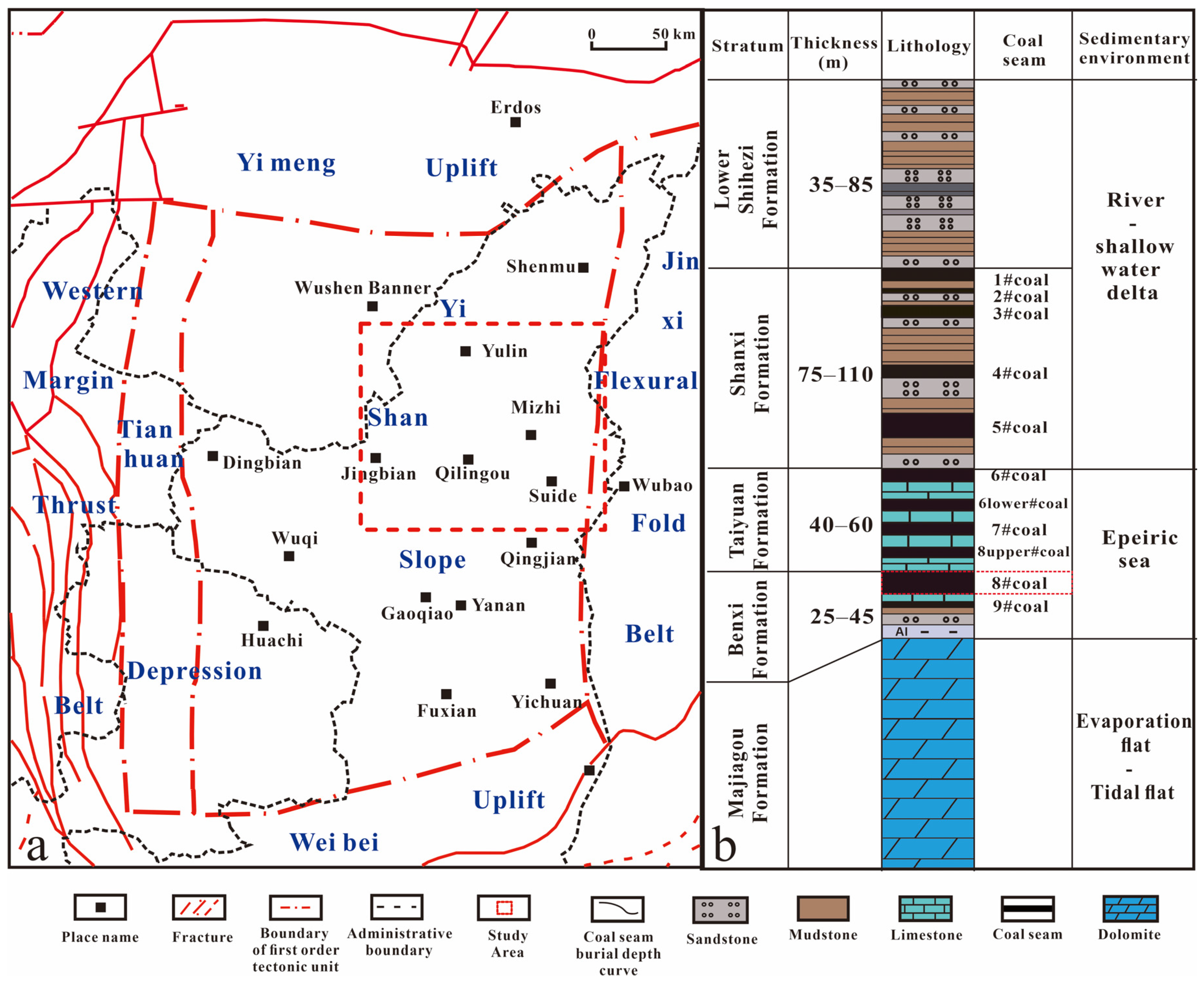
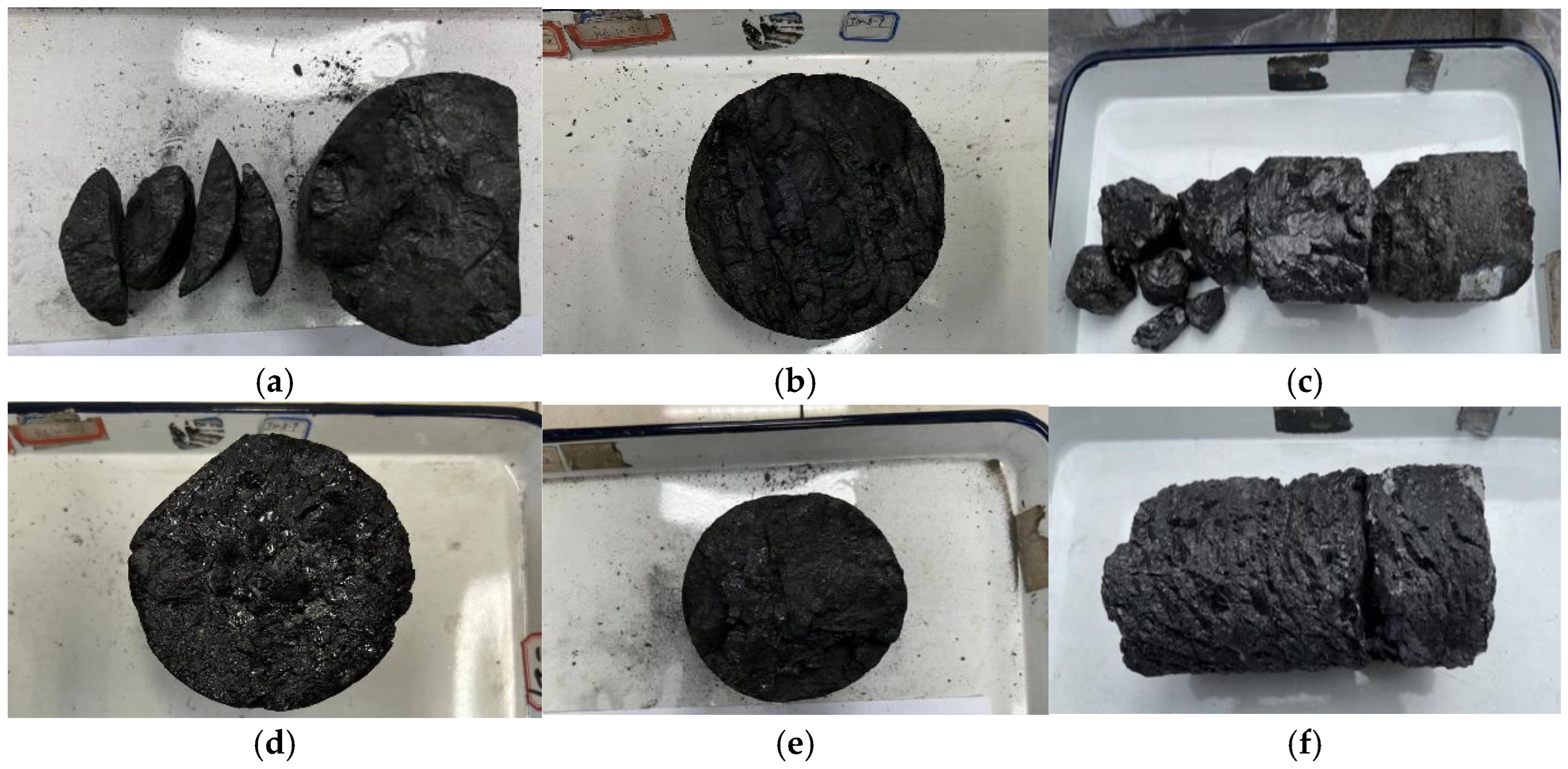

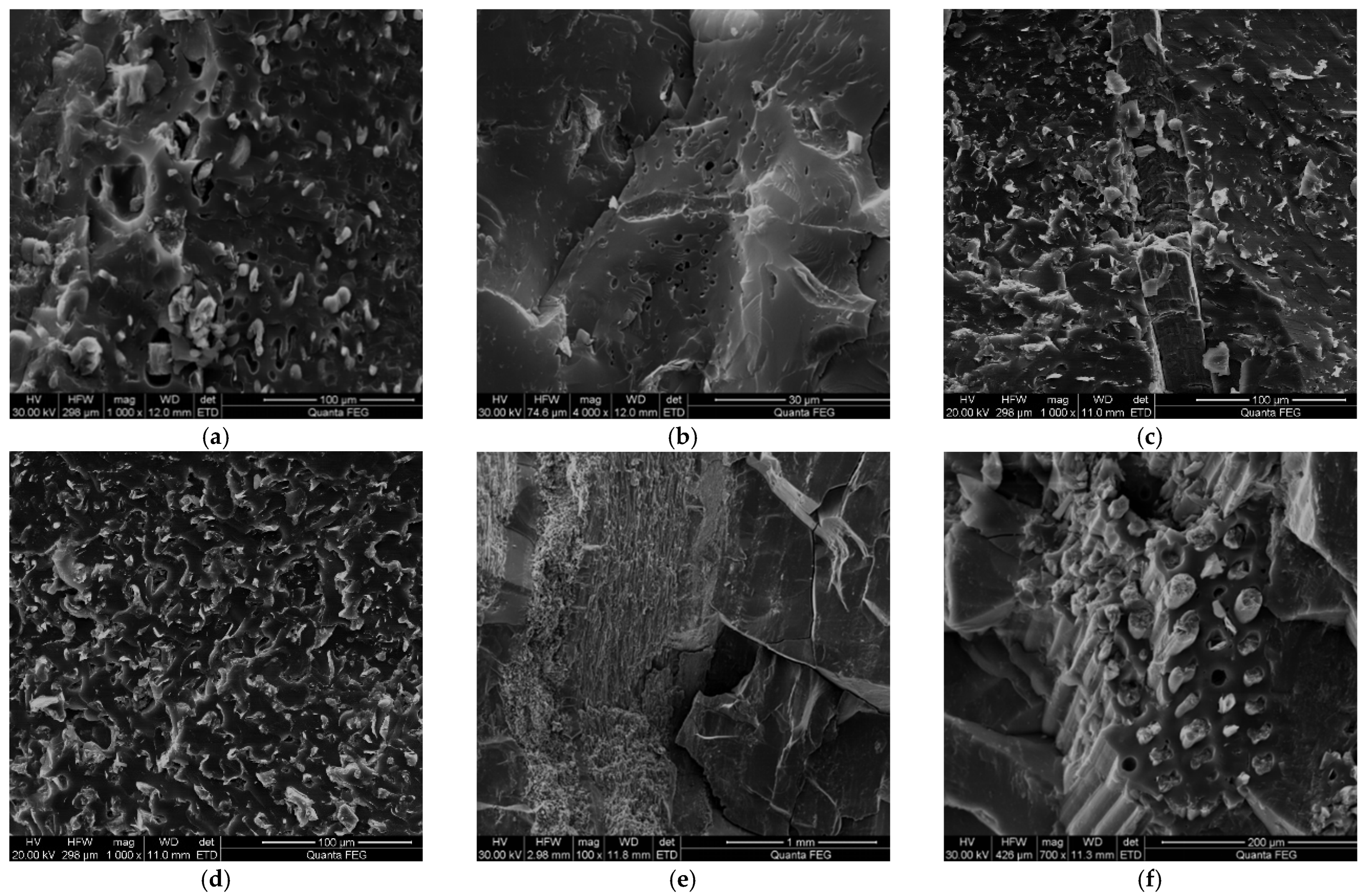




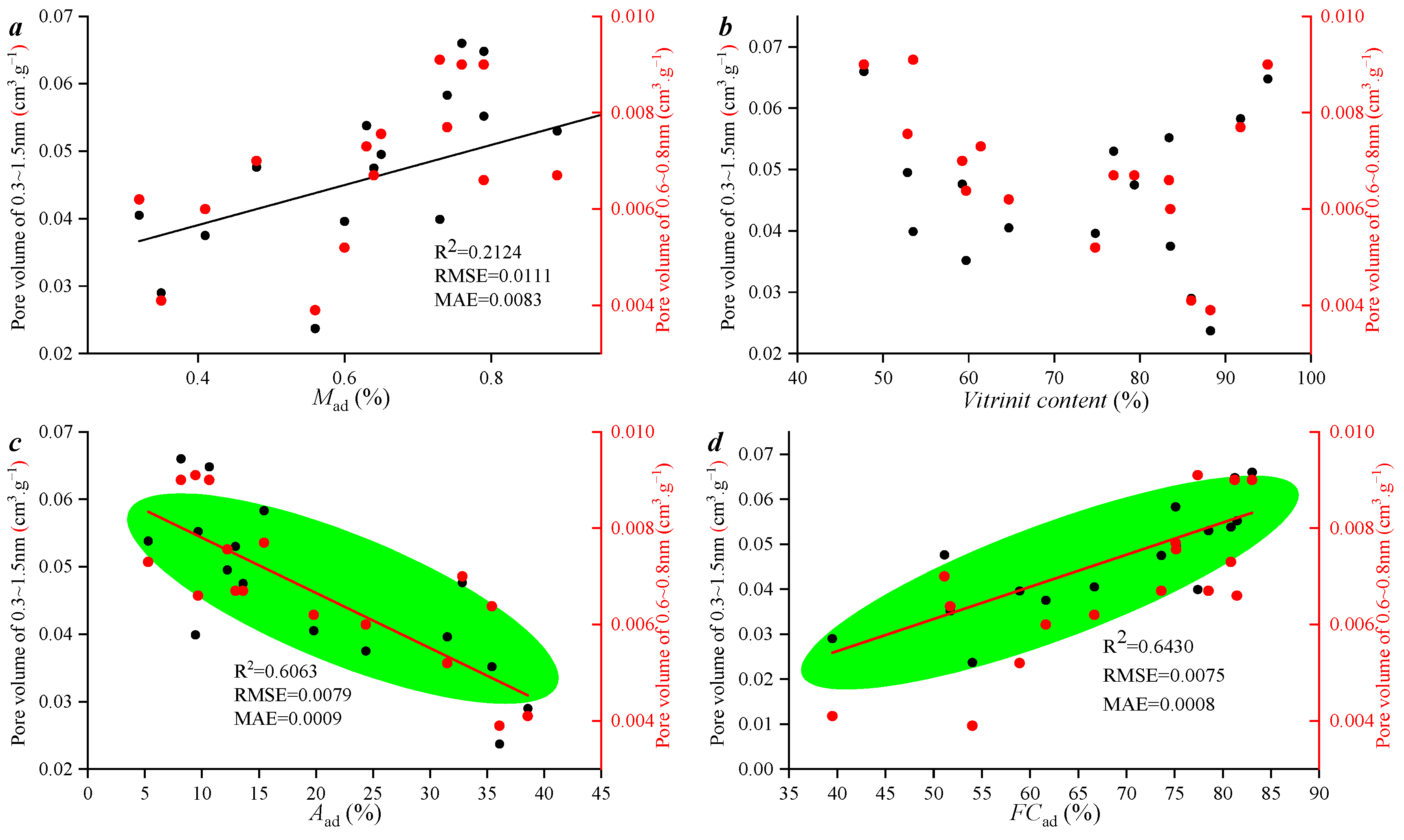


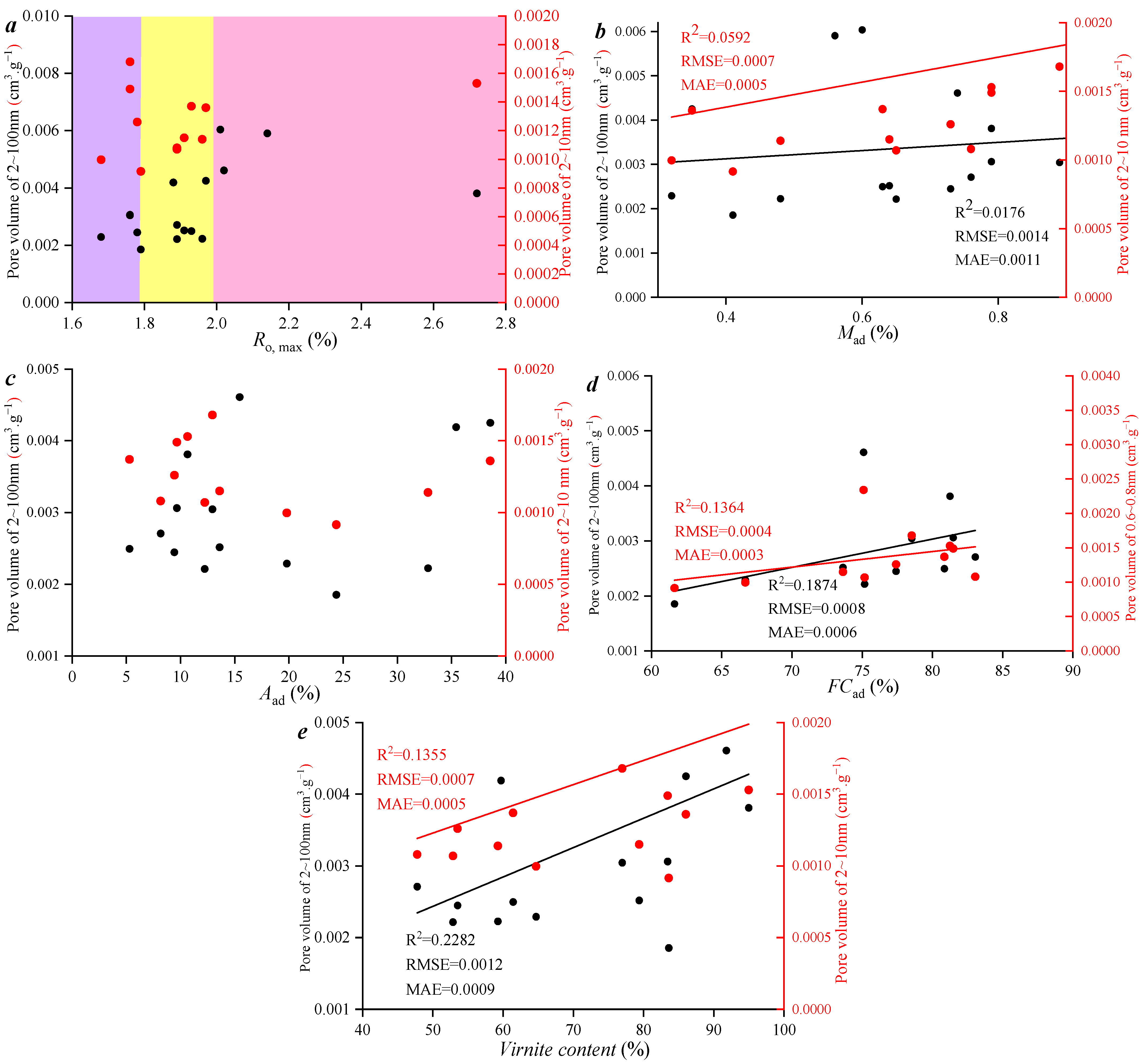


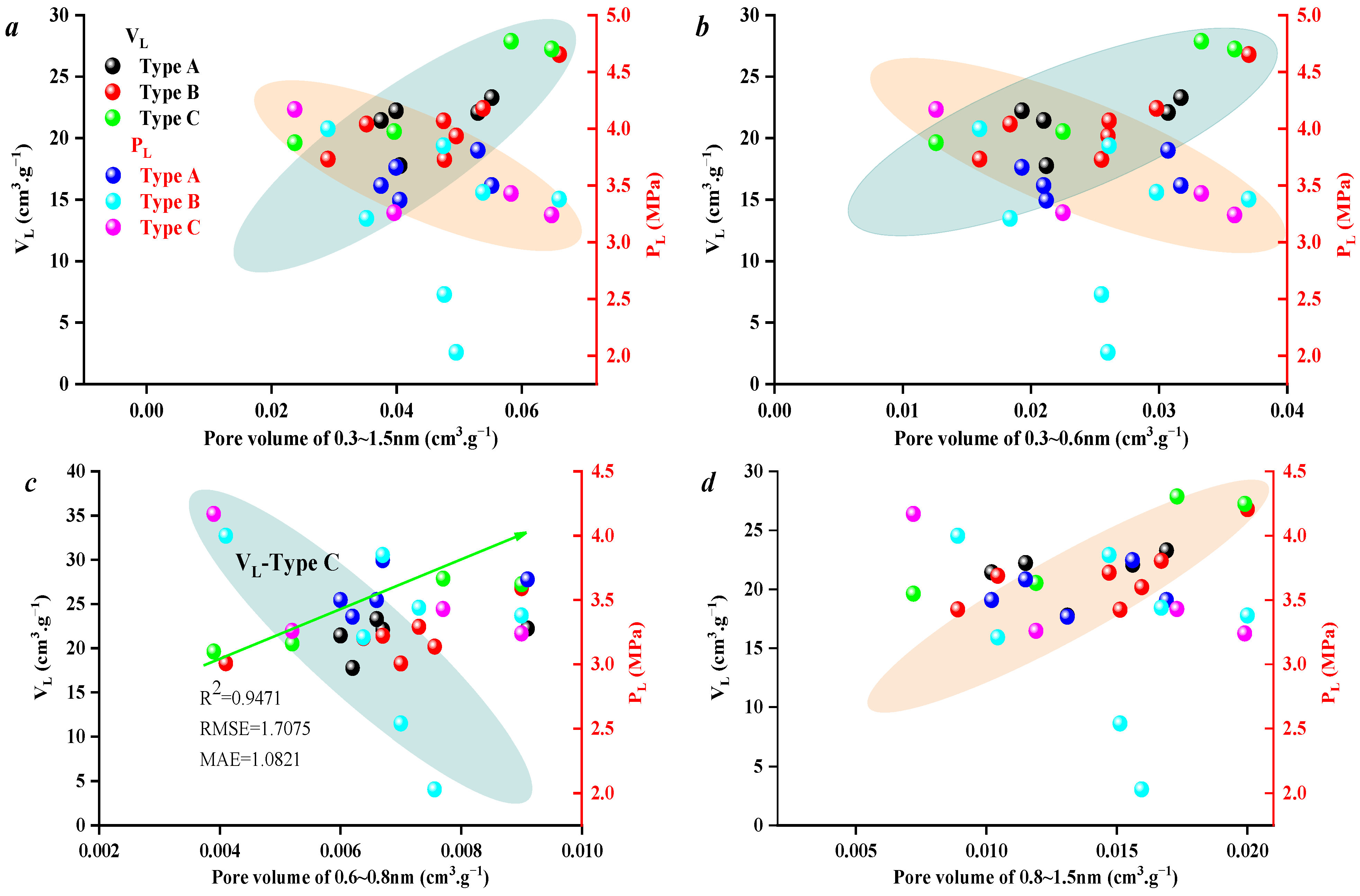

| Sample No. | Ro,max | Vitrinite | Liptinite (%) | Inertinite | Mineral | Mad | Aad | Vad | FCad |
|---|---|---|---|---|---|---|---|---|---|
| (%) | (%) | (%) | Components (%) | (%) | (%) | (%) | (%) | ||
| M1 | 1.68 | 64.7 | / | 35.29 | 0.01 | 0.32 | 19.8 | 13.2 | 66.68 |
| M2 | 1.76 | 76.96 | / | 23.06 | 6.18 | 0.89 | 12.94 | 7.64 | 78.53 |
| M3 | 1.76 | 83.43 | / | 16.5 | 5.87 | 0.79 | 9.66 | 8.07 | 81.48 |
| M4 | 1.78 | 53.52 | / | 46.348 | 0.132 | 0.73 | 9.43 | 12.43 | 77.41 |
| M5 | 1.79 | 83.59 | / | 16.41 | 0.098 | 0.41 | 24.37 | 13.58 | 61.64 |
| M6 | 1.88 | 59.71 | 4.03 | 45.12 | 9 | 0.98 | 35.42 | 11.88 | 51.72 |
| M7 | 1.89 | 52.86 | 2.02 | 36.26 | 1 | 0.65 | 12.23 | 11.95 | 75.17 |
| M8 | 1.89 | 47.77 | 1.62 | 50.61 | / | 0.76 | 8.16 | 8.03 | 83.05 |
| M9 | 1.91 | 79.38 | / | 38.56 | 0.01 | 0.64 | 13.6 | 12.13 | 73.63 |
| M10 | 1.93 | 61.43 | / | 20.76 | 0 | 0.63 | 5.29 | 13.23 | 80.85 |
| M11 | 1.96 | 59.26 | 2.36 | 38.38 | 1 | 0.48 | 32.83 | 15.57 | 51.12 |
| M12 | 1.97 | 86.03 | 2.79 | 11.17 | / | 0.35 | 38.57 | 21.59 | 39.49 |
| M13 | 2.01 | 74.81 | / | 25.13 | 5.66 | 0.6 | 31.51 | 8.97 | 58.92 |
| M14 | 2.02 | 91.79 | 1.93 | 6.28 | / | 0.74 | 15.45 | 8.71 | 75.1 |
| M15 | 2.14 | 88.27 | / | 11.72 | 18.21 | 0.56 | 36.09 | 9.33 | 54.02 |
| M16 | 2.72 | 94.97 | 2.52 | 2.52 | / | 0.79 | 10.64 | 7.32 | 81.25 |
Disclaimer/Publisher’s Note: The statements, opinions and data contained in all publications are solely those of the individual author(s) and contributor(s) and not of MDPI and/or the editor(s). MDPI and/or the editor(s) disclaim responsibility for any injury to people or property resulting from any ideas, methods, instructions or products referred to in the content. |
© 2025 by the authors. Licensee MDPI, Basel, Switzerland. This article is an open access article distributed under the terms and conditions of the Creative Commons Attribution (CC BY) license (https://creativecommons.org/licenses/by/4.0/).
Share and Cite
He, Y.; Wan, J.; Yang, R.; Han, S.; Yang, X.; Zeng, J.; Gao, H. Effects of Thermal Evolution Degree and Industrial Components on Pore Fracture Distribution Heterogeneity in Deep Coal Reservoirs. Processes 2025, 13, 710. https://doi.org/10.3390/pr13030710
He Y, Wan J, Yang R, Han S, Yang X, Zeng J, Gao H. Effects of Thermal Evolution Degree and Industrial Components on Pore Fracture Distribution Heterogeneity in Deep Coal Reservoirs. Processes. 2025; 13(3):710. https://doi.org/10.3390/pr13030710
Chicago/Turabian StyleHe, Yufei, Jinbin Wan, Renjie Yang, Shuangbiao Han, Xiaoming Yang, Jingbo Zeng, and Hongtao Gao. 2025. "Effects of Thermal Evolution Degree and Industrial Components on Pore Fracture Distribution Heterogeneity in Deep Coal Reservoirs" Processes 13, no. 3: 710. https://doi.org/10.3390/pr13030710
APA StyleHe, Y., Wan, J., Yang, R., Han, S., Yang, X., Zeng, J., & Gao, H. (2025). Effects of Thermal Evolution Degree and Industrial Components on Pore Fracture Distribution Heterogeneity in Deep Coal Reservoirs. Processes, 13(3), 710. https://doi.org/10.3390/pr13030710





